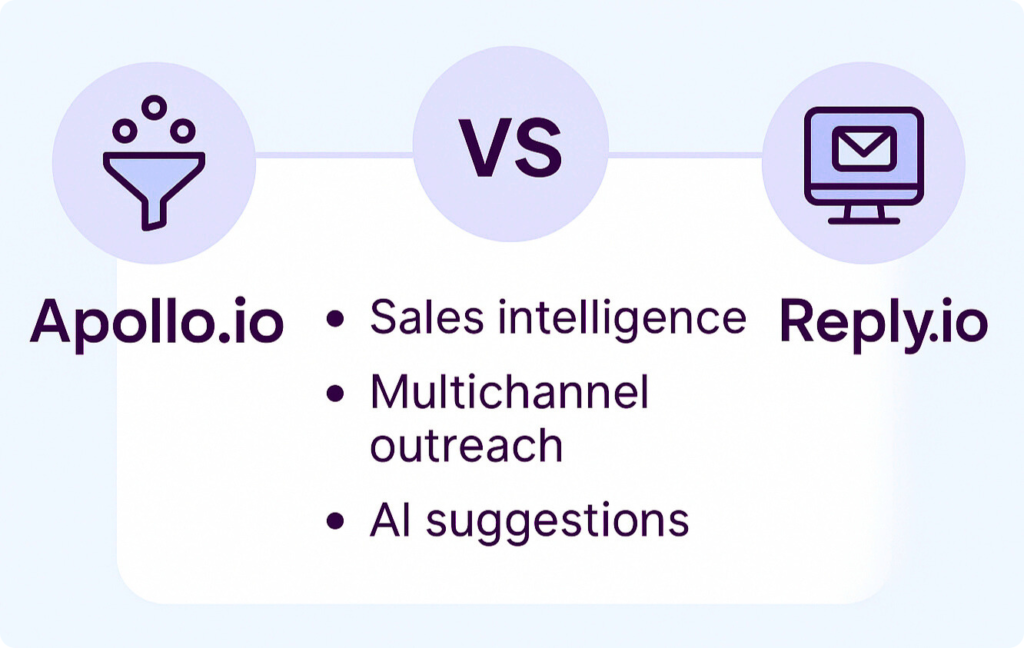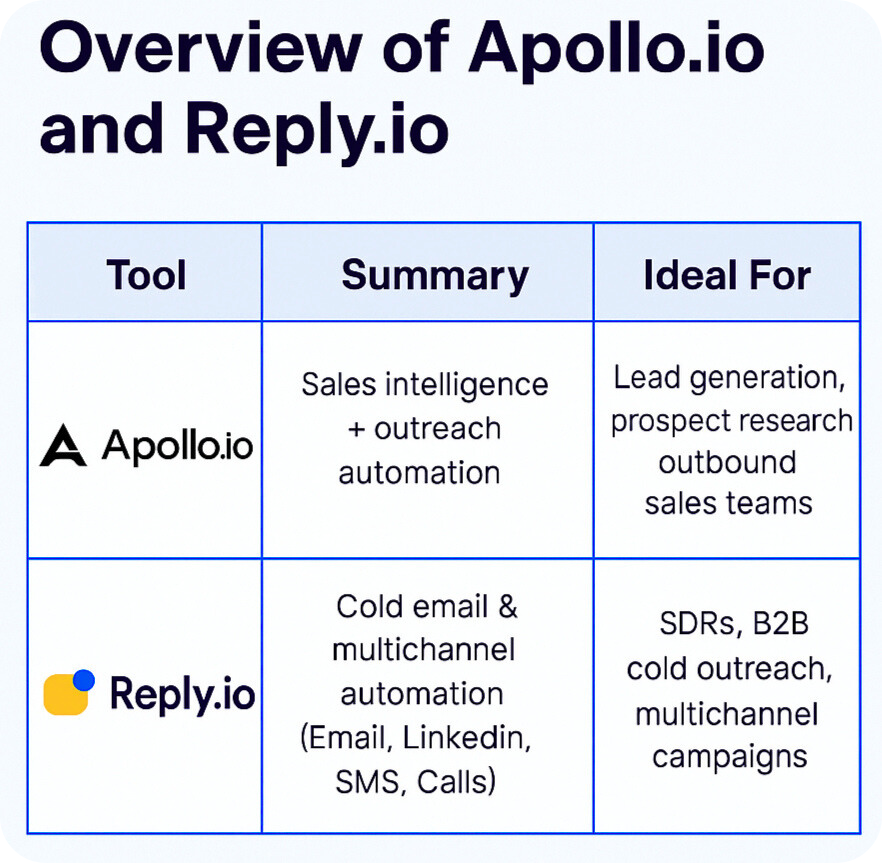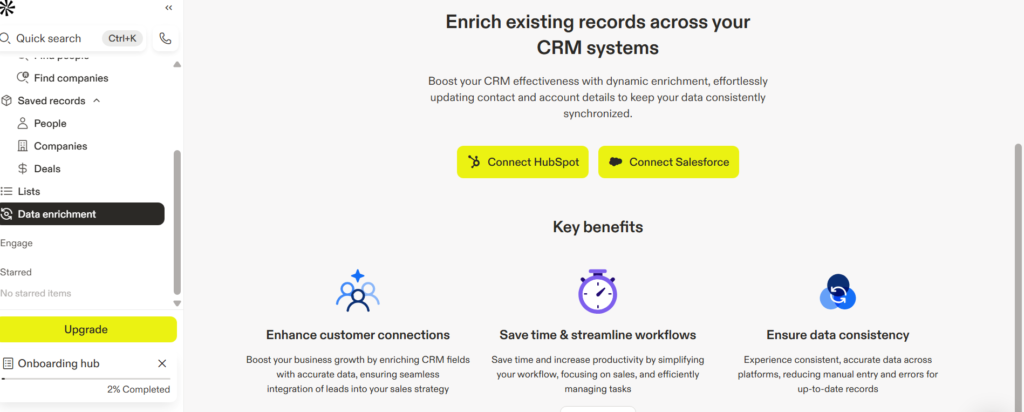Apollo.io vs Reply.io: Which Sales Outreach Tool Wins in 2025?
The Rise of AI-Driven Sales Tools
In today’s fast-moving B2B landscape, traditional sales outreach no longer cuts it. Businesses are now turning to AI-powered sales tools to find leads faster, personalize outreach at scale, and close deals more efficiently than ever. Whether you’re a startup founder, a sales development rep (SDR), or part of a growing B2B agency, having the right sales tool in your tech stack can make or break your results.
That’s where platforms like Apollo and Reply come into play. Both tools promise smart, automated outreach—but they do it in different ways. And with so many features (email finders, sequences, CRM sync, AI assistants), it’s easy to feel overwhelmed when choosing the right one.

That’s why we created this Apollo vs Reply comparison—to help you make a clear, confident decision. By the end of this article, you’ll understand how these tools work, what makes each one stand out, and which is the better fit for your business needs.
So, if you’re ready to level up your cold outreach strategy, let’s dive into the features, pricing, pros, and use cases of Reply.io vs Apollo.io.
Overview of Apollo.io and Reply.io
When it comes to streamlining outbound sales, Apollo.io and Reply.io are two of the most trusted tools in the B2B world. While both platforms help automate and scale outreach efforts, they serve slightly different purposes based on your team’s goals and workflow style.

The key difference between Apollo.io and Reply.io is how they begin their process. Apollo.io starts with helping you find the right people to reach out to, while Reply.io focuses on sending the right message through multiple channels.
If you’re new to sales automation, think of Apollo.io and Reply.io like this:
- Apollo.io = Your contact database + smart outreach.
- Reply.io = Your communication control center.
Choosing between Apollo.io and Reply.io depends on whether you need help finding leads or engaging with them at scale.
Key Features Comparison: Apollo.io vs Reply.io
| Feature | Apollo.io | Reply.io |
| Cold Email Sequences | ✅ Yes | ✅ Yes |
| LinkedIn Automation | ❌ No | ✅ Yes |
| Email Finder & Verifier | ✅ Yes (Robust & accurate) | ✅ Yes (Built-in but limited) |
| AI Writer | 🟡 Basic | ✅ Advanced AI writing assistance |
| CRM Integration | ✅ Yes (HubSpot, Salesforce, others) | ✅ Yes (Zapier, HubSpot) |
| Multichannel Outreach | 🚫 No (Email only natively) | ✅ Yes (Email, LinkedIn, SMS, Calls) |
| Chrome Extension | ✅ Yes | ✅ Yes |
| A/B Testing | ✅ Yes | ✅ Yes |
Pricing Comparison
| Plan | Apollo.io | Reply.io |
| Free Plan | ✅ (generous) | ✅ |
| Starter | From $49/mo | From $60/mo |
| Professional | $99–$149/mo | $90+/mo |
| Enterprise | Custom | Custom |
Which Tool is Better for You? (Apollo.io vs Reply.io)
Not sure which tool to start with? Here’s a simple breakdown to help you decide based on your role or business size.
👤 Solo Founders or Freelancers
✅ Best Pick: Apollo.io Free Plan or Starter Plan
If you’re just getting started with outbound outreach or testing cold email campaigns, Apollo.io’s Free plan gives you:
- 100–200 verified emails/month
- Access to their powerful contact database
- Basic automation features
It’s perfect for learning and building your outreach process without spending upfront.
✅ Want a deeper look into this platform? Check out our in-depth Apollo.io review to explore features, pros, cons, and real use cases tailored for small businesses and solo entrepreneurs.
👥 Small Agencies or Consultants
✅ Best Pick: Reply.io Starter or Professional Plan
Running outreach for multiple clients or building multi-touch sequences? Reply.io offers:
- Seamless multichannel support (Email + LinkedIn + Calls + SMS)
- Advanced automation and AI writer tools
- Shared inboxes and collaborative features
This helps you scale across clients efficiently without juggling multiple tools.
Still undecided? Read our Reply.io review for hands-on insights before choosing the right tool.
Sales Teams or Scaling Startups
✅ Best Pick: Apollo.io Professional OR Reply.io Professional
Need more power, CRM integrations, and team collaboration? Both tools offer solid capabilities, but the choice depends on your workflow:
- Choose Apollo Pro if your focus is finding leads + email outreach
- Go with Reply Pro if your sales reps rely on LinkedIn + personalized automation + multichannel touchpoints
Final Tip
If you’re unsure, start with Apollo’s free plan to explore lead data, and try Reply.io’s free trial to test multichannel campaigns. Most users get a clear sense of what suits them within a few days — and that’s when your affiliate suggestion becomes valuable!
User Experience & Interface
When choosing a sales outreach tool, user experience can make or break your workflow—especially if you’re a beginner or a busy founder.
Apollo.io: Data-Rich but Slightly Complex
Apollo.io offers a data-centric interface. It’s packed with filters, lead insights, and CRM-style dashboards. While powerful, it might feel a bit overwhelming for first-time users.
🔍 If you’re comfortable navigating tools like CRMs or want deep control over your lead filters and contact lists, you’ll enjoy Apollo’s detailed UI.
✅ Best for: Sales pros, marketers, and agencies that do a lot of prospect research and lead management.
🟩 Reply.io: Clean, Simple, and Easy to Learn
Reply.io shines in simplicity. Its interface is built for fast execution: just plug in your leads, write your messages, and launch campaigns. It guides you step-by-step — making it ideal for beginners.
✅ You’ll see clear tabs for:
- Campaigns
- People (prospects)
- Tasks
- Reports
It feels more like a marketing automation tool, rather than a database-heavy CRM.
✅ Best for: Solo founders, SDRs, or anyone who wants to send emails or LinkedIn messages without dealing with complex dashboards.
“Apollo.io provides deep lead data. Reply.io simplifies multichannel campaigns.”
Use Case Scenarios
Still unsure which tool fits your workflow? Let’s break it down based on your specific goals.
If your focus is finding high-quality leads
Go with Apollo.io
Apollo’s massive B2B contact database helps you search, filter, and find ideal prospects by company size, job role, revenue, industry, and more.
✅ Built-in email finder + verification
✅ Advanced filters to target decision-makers
✅ Great for cold outreach campaigns from scratch·
·
If your focus is multichannel outreach with existing leads
Choose Reply.io
Reply helps you build and automate campaigns using email + LinkedIn + SMS + phone calls, all in one place.
✅ Smart campaign flows
✅ AI writing assistance for your messages
✅ Perfect if you already have a lead list and want to automate the follow-up
·
Want to run B2B email + LinkedIn campaigns together?
Reply.io is the better pick here.
It lets you create LinkedIn touchpoints + emails in the same sequence, increasing engagement.

·
Want a tool with CRM-style lead tracking and discovery?
Apollo.io is ideal.
With contact activity history, task scheduling, and contact enrichment, it works well as a light CRM replacement too.
| Use Case | Best Tool |
| Finding targeted B2B leads | Apollo.io ✅ |
| Automating outreach to existing leads | Reply.io ✅ |
| Email + LinkedIn campaign combo | Reply.io ✅ |
| CRM-style contact + task management | Apollo.io ✅ |
| Simple UI for quick campaign building | Reply.io ✅ |
| Deep lead database & research filters | Apollo.io ✅ |
Pros and Cons
Apollo.io Pros
- Massive lead database
- Built-in enrichment
- Excellent for cold lead discovery
Apollo.io Cons
- No native multichannel
- More complex UI
Reply.io Pros
- Powerful multichannel flows
- AI-powered copy & send time
- Easy to use for outreach campaigns
Reply.io Cons
- Smaller database
- Slightly higher cost at scale
Integrations & Ecosystem
- Apollo: Strong native data & CRM support
- Reply: Great with tools like Zapier, HubSpot, Pipedrive
Include icons of popular CRM/email marketing platforms.
What Users Are Saying

“Apollo.io isn’t just a lead database — it bridges the gap between sales outreach and marketing workflows. This article showcases real business use cases from their own blog to inspire practical usage.”

“Reply.io powers high-performing sales teams with automated outbound emailing that scales. This trusted review shows its real-world impact in driving pipeline growth.”
Final Verdict – Which One is Best for You?
- ✅ Choose Apollo.io if you need strong lead generation, research, and enrichment
- ✅ Choose Reply.io if your priority is outreach automation across multiple channels
“Still unsure? Try both platforms free and see which fits your sales flow better.”
❓ FAQs – Apollo.io vs Reply.io
1. What is the main difference between Apollo.io and Reply.io?
Apollo.io is primarily a sales intelligence and lead generation platform, helping users find verified contact data and manage prospecting.
Reply.io focuses on automated outreach across multiple channels like email, LinkedIn, SMS, and calls, making it ideal for executing cold outreach campaigns.
2. Is Reply.io better than Apollo.io for cold email campaigns?
Yes, Reply.io is better suited for cold email automation and multichannel outreach. It offers tools like A/B testing, AI writing assistant, and native LinkedIn automation, which Apollo.io lacks in its outreach module.
3. Does Apollo.io offer LinkedIn automation like Reply.io?
No, Apollo.io does not provide native LinkedIn automation. If you want to combine LinkedIn + email sequences in one flow, Reply.io is a better choice.
4. Which platform is best for solo founders or small teams?
For solo founders, Apollo.io’s free or Starter plan is a great way to build lead lists and test outreach.
For small teams or agencies, Reply.io’s Professional plan is ideal due to its user-friendly dashboard, multichannel flows, and collaborative features.
5. Can I use Apollo.io and Reply.io together?
Yes, many users use Apollo.io for lead generation and export contacts to Reply.io for outreach. This combo works well for teams needing both strong data and automated outreach workflows.
6. Which is easier to use for beginners – Apollo or Reply?
Reply.io has a simpler, more beginner-friendly interface, especially for users new to sales automation. Apollo.io offers more data and filters but may feel dense for first-timers.

